Solar covers help maintain warmer water as well as prevent the evaporation of water and chemicals, both which save you money! There are several ways to solar heat your pool, but solar covers are the most effective way to harness the sun’s energy.
Solar Cover Selection
A recent study shows that Solar Blankets stop 5-times more evaporative heat loss, when compared to Liquid Solar Covers and Solar Sun Rings.
We like to say that we have a solar blanket for every budget. Once you select the size of solar blanket – you’ll be presented with several choices of color and thickness. Solar covers come in 8 mil, 12 mil and 16 mil – each with longer warranty periods.
For color choices, you can select from our standard Blue solar blankets in 8 or 12 mil, or upgrade to our Blue/Black solar cover in 12 mil, with a dark bottom to trap more heat in the pool. For the most durability and highest heat gain, look at the 16 mil Ultra Clear (opaque actually) blankets. We offer a wide selection of solar covers to meet any budget, and pool heating needs.
8 Mil Solar Cover
- Thinnest cover, lightweight
- Lowest price
- Increases pool temperature up to 10ºF
- 3-year limited warranty
12 Mil Solar Cover
- Happy medium for thickness and weight
- Moderate price
- Increases pool temperature up to 15ºF
- 7-year limited warranty
16 Mil Solar Cover
- Thickest cover, heavier weight
- Highest price
- Increases pool temperature up to 18ºF
- 8-year limited warranty
How to Compare Pool Solar Covers
Solar blankets are made from a UV-stabilized form of polyethylene or polypropylene material. Larger pool blankets are made from rolls of material that are heat sealed together. The better solar pool covers are made of an extruded one-piece material, rather than a laminated top and bottom, and will be thicker, with longer warranty periods.
Solar Cover Sizing

To determine what size solar pool cover you need, simply measure the longest and widest points of the pool. When the cover is installed, it’s best to completely cover the water surface, so there aren’t any gaps for heat to escape. Solar covers are easily cut to fit – freeform or kidney shaped pools use an rectangular size that completely covers the pool, and trim it down to fit the pool shape.
Solar covers are available in round, oval or rectangular shapes. You may notice we sell in-ground and above ground solar covers, but there is no difference in the material. Generally, oval and round covers are installed on above ground pools and rectangular covers on in ground pools, but depending on your pool shape – you may be better off purchasing oval or round above ground solar covers for your in-ground pool.
“L” shaped pools or other large pools may find it better to buy two (or more) smaller solar blankets, instead of buying one larger cover and cutting it to size. It may be cheaper overall, in addition to reducing material waste.
For pools with a step section that needs to be covered, don’t worry about purchasing an oversized blanket and cutting to size, just purchase a step section piece. In The Swim offers 4’x8’ pieces of solar blanket for step sections in 12mil and 16mil material.
If your pool is larger than our largest 30×60 rectangle, 21×41 oval or 33 round, keep in mind that In The Swim can special order larger sizes, custom solar covers, in nearly any square or rectangular size you want. You will still need to trim it if you have a free form pool shape.
Solar Cover Installation
If your pool is rectangular, round or oval and you were able to find a cover that is your exact pool size, then the job of installing your solar blanket is pretty easy – simply lay the cover on the pool with the bubble side facing down, and the smooth side facing up.

Place some light weights around the cover to hold it in place. Nothing too heavy or sharp, of course, you don’t want to damage the cover. Winter cover water tubes would be a good choice. Don’t worry about the cover being drum-tight, it should be floating on the water, and evenly overlapping the pool coping.
Once you have the cover in place, carefully cut two sides of the solar cover around the perimeter of the pool, cutting right up against the coping inside edge, to make sure there won’t be any gaps between the cover and the pool wall when it is lying on the water. When half of the cover is cut, use your pool brush to push the cut sides up against the edge of the pool, and to smooth out the blanket, removing air bubbles beneath.
For pools with lots of surrounding trees and debris, some folks like to cut the cover larger, to keep leaves from falling in around the edges. This works best on rectangular pools – it’s harder to get the solar blanket to lay flat against curved wall sections.
Solar Cover Use
Generally speaking, you should have the solar cover on the pool whenever the pool is not being used. During the day, having the cover on the pool helps to prevent water and chemical evaporation in the hot sun and also warms the pool. At night it will help to insulate the water, to retain the heat you have gained throughout the day.
There are times when you should not use a solar cover. Remove the cover during heavy storms and wind events, to prevent damage from flying debris. Remove the cover before shocking a pool, and leave it off until chlorine levels drop below 2.5 ppm. Low pH and alkalinity, and low hardness (soft water) can also damage solar blanket material.
Solar Cover Care
Solar covers are durable as they can be while remaining flexible, but are subject to damage from unbalanced water, and quickly deteriorate with high levels of chlorine. Important to note – as chemical damage is not covered under any warranty.
High Chlorine:
Solar covers should never be used after shocking or super-chlorinating the pool. Leave a solar cover safely stored in the shade whenever chlorine level is higher than 2.5 ppm.
Low pH:
Solar covers will also degrade in acidic pH levels, when pH falls below neutral 7.0.
Low Calcium:
Very soft water with calcium hardness levels below 150 ppm, can literally suck the plasticizers directly out of your solar blanket, making it rigid and crispy.
Using solar blanket reels can extend the life of your solar blanket. Keeping it rolled up prevents pinching and folding, and protects the cover from (some) damaging UV rays. Reels also make it easier to clean the cover while removing it from the pool, and lets you roll the cover out of the way, or into the shade.
Solar Degradation:
When rolled on a solar reel, or folded on the deck, layers of solar blanket material focus and magnify the sun’s rays onto deeper layers, which weakens the material and can discolor the cover with a ‘sun-burn’ (also not covered under warranty).
It’s a bit ironic that the sun can damage a solar blanket, but if left rolled up or folded in one sunny spot during hot summer months (or all winter long), solar covers will fail faster.
Cover your cover while on the reel with the Solar Cover Poly Tarp, a long piece of white plastic with Velcro attachments, or for greater protection use the heavy-duty Solar Cover Winter Cover, both available in several sizes to fit your reel perfectly.
Winter Solar Cover Care

During winter, store your solar blanket out of the elements, indoors if possible, as very cold cold temps can cause cold cracking. Do not leave a solar blanket on the pool during winter.
Clean and dry your solar blanket, then fold or roll it up for safe storage. A large Rubbermaid bin or upright drum can be used for maximum protection from sun, dirt and nesting rodents.
The US Department of Energy would like pool owners to increase their use of pool covers, to reduce energy demands and pool heater emissions. Do your part by investing in a solar blanket that will save you money and make your swimming pool more enjoyable.

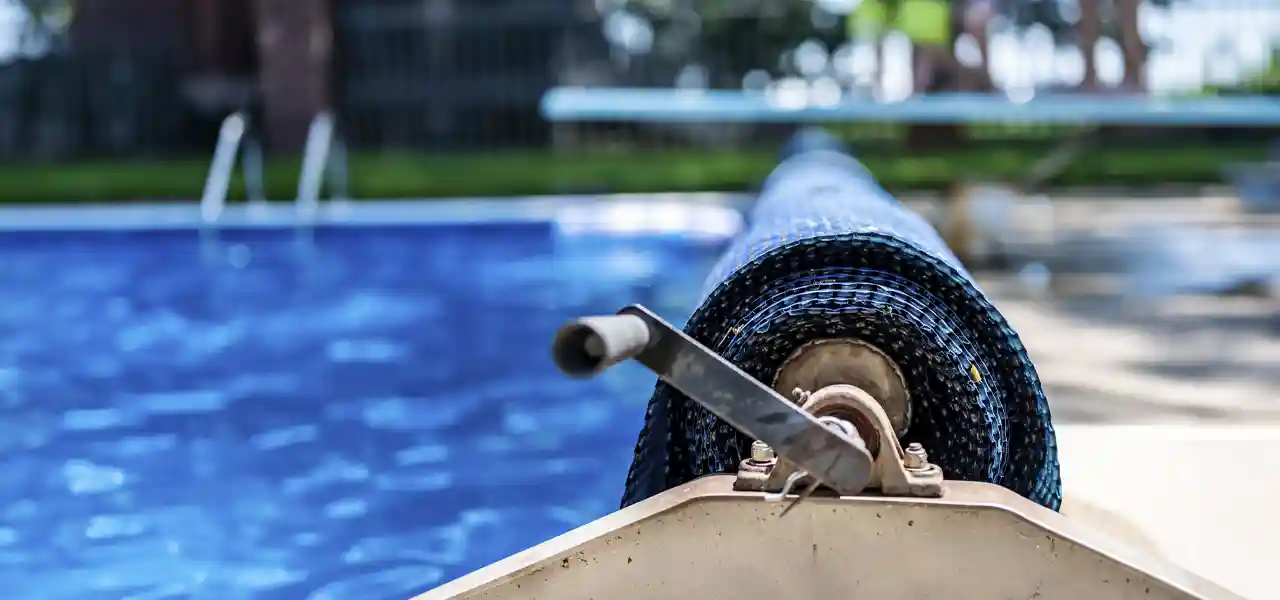
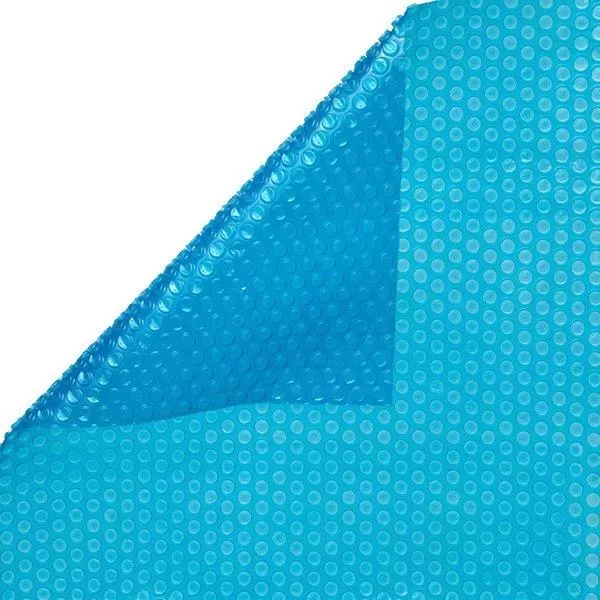
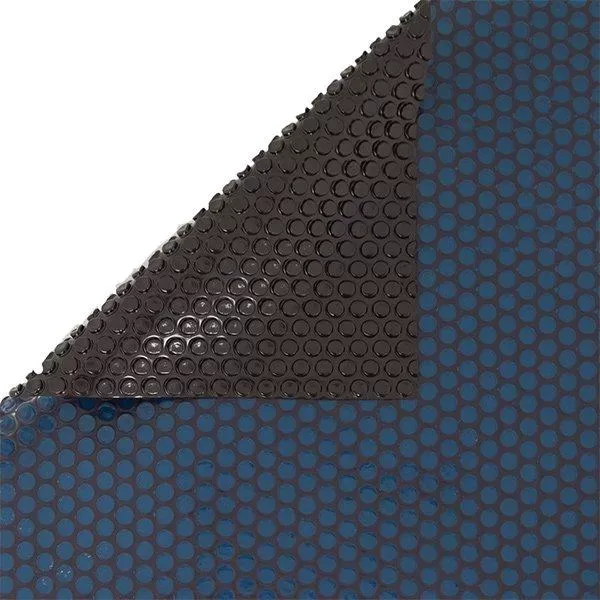
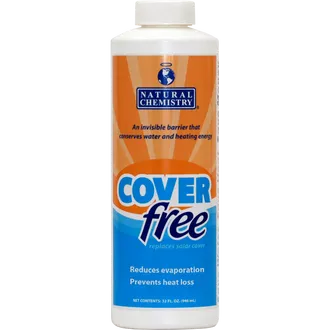
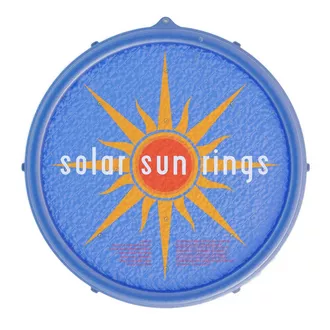

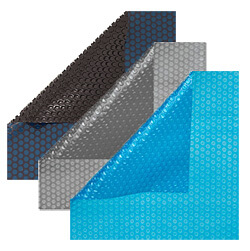
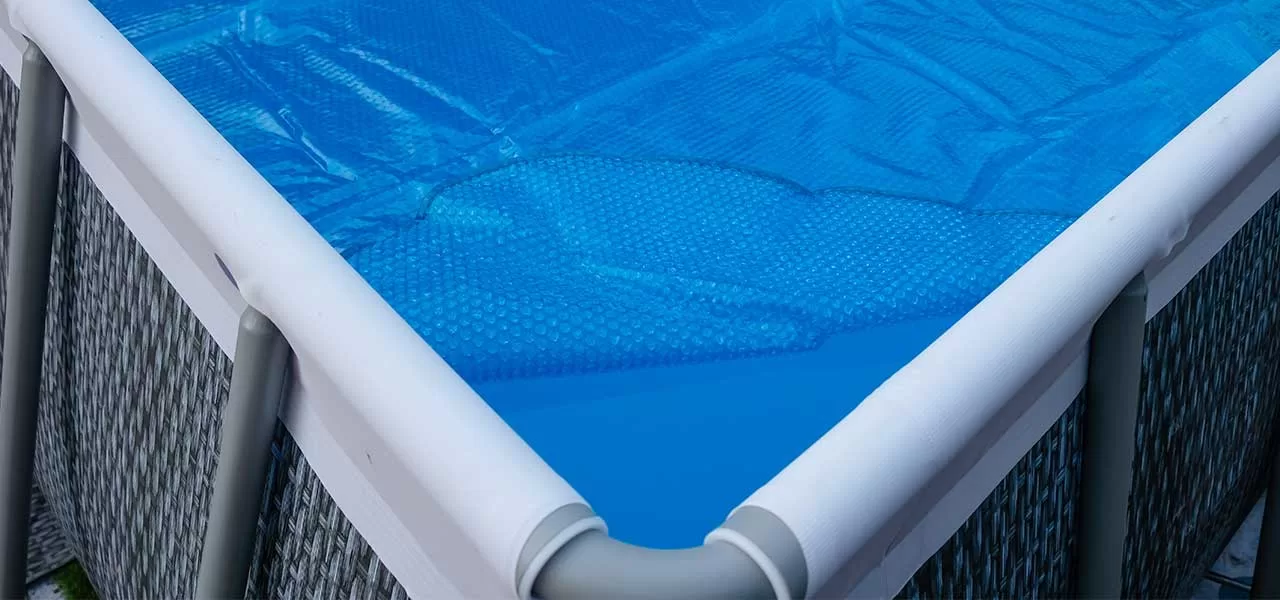
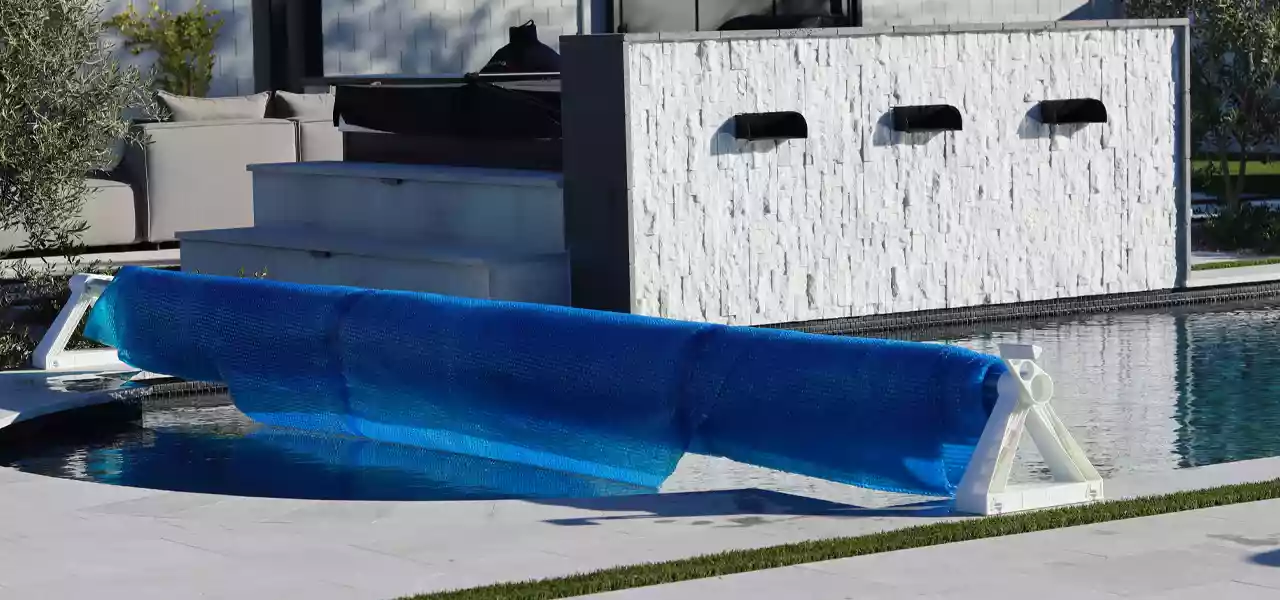
I purchased the 21′ round 8 mil solar cover for my advice ground pool. I live in Arizona so I don’t need it for heating the pool but to keep debris out especially when we have dust storms. Do I keep my floating chlorinator in the pool while the cover is on (which will be almost 24/7)? I’ve noticed the floater doesn’t move and I’m concerned it will impact the chlorine level and/or the cover.
Hi Dana, keep that floater in the pool! It does not matter if it does not move around, the tablets are still submerged in water, and still chlorinating. Chlorine is bad for covers, but normal levels are ok, just keep the cover off after shocking the pool, or when chlorine is more than 3 ppm.
We have a 24′ above ground round pool. We just purchased a solar cover off a resale site. Is it okay to run the pool pump with the cover installed on top of the water? I assume it will just spin in a circle as the water rotates 🙂
Hi Karen, yes it’s ok, it may spin, but probably not too much actually. Just be sure to remove the cover after shocking, until chlorine level falls to normal. And when you store it off the pool, put it in the shade so the sun won’t damage it while folded, and don’t lay it on the grass, it can burn the grass, plus get dirty.
We just purchased a solar cover and reel system for our inground pool. It is an irregular shaped pool. We cut the cover to the shape of our pool, and fold it over on two spots to make it a rectangle. But when we roll it up, it bunches up a lot on one end of the reel. Would it make more sense to cut those odd sections off and just lay them down when we put the cover on?
Michele, you could do that. Some people do, cut off the outer radius sections. Or just let it bunch up on the ends, that won’t hurt anything. Your choice!
We have a 28 foot round above ground pool. We have a solar blanket that is such a chore to get off and put back on in the evening. We’re thinking about getting one of the reel systems. Taking the cover off using a reel seems simple enough, but I’ve never seen anyone address putting the cover back on the pool using the reel. How does that work?
Hi David, solar reels do make it easier to work with a solar blanket, but still… 🙂 Putting the cover back on is simple enough, some people connect a long rope to the end of the solar cover, best with two clamps, for less stress on cover. Or one person can grab the cover while in the water and pull it to the other side, or two people can easily grab each side and pull it across. Or even one person can do it outside of the pool, but you will have to walk around the pool a few times to get it right.
Hello, I have a free form pool and just purchased you solar pool cover rectangle shape 18’x38′. In the middle of pool there is an island with two jets that circulate the water (salt water pool). How should the cover be installed as the jets run for 8 hours during the day? Example if the cover is under the jet spouts and water is coming out of them wouldn’t the water damage the cover and bring water level high or if the cover is over the jets and water is shooting out? First time pool owner – can’t you tell.
Hi Kim, There are several options, You may start with just letting the water spout fall on the cover, and see how that does. I dont’ think it will damage the cover, but depending on the volume, it could flood or partially submerge the cover – if so, then you could cut/trim the solar cover to leave open (not cover) the area where the jet water lands. Another option is to use the Solar Rings, which can be easier to use on some freeform shapes, or pools with islands (sounds nice).
I have a 18×36 kidney shape pool. What size cover should I get?
Hi Summer, get an 18×36 rectangular cover, and lay it over the pool for a few hours in the sun, to work out the packing wrinkles. Then stretch it tight across the pool, and use scissors or a razor knife to cut the blanket, right along the coping edge, trying to cut a little larger than needed. Like a haircut, you can always trim more, but cannot put any back! (*it’s not the end of the world if there are small gaps, so dont stress about getting the cut perfect)
Hi, in this article you say that you can make custom solar cover sizes, my pool is 14*84 (25m x 4m).
Yet yesterday your chat line told me no and didn’t give me an idea on how to glue pieces together.
Which one is it?
Hi Jean, we can do custom solar blankets, of a specific size (but always rectangular), but they can be quite costly, and – when they get as long as 84′, the box size becomes huge, which makes shipping very costly. And, you will need a very large reel to hold such a long blanket, when rolled up, the roll can have a very large diameter. We also cannot ship it internationally, if your pool is outside the US.
What I would suggest is using 3 of the 14’x28′ rectangular blankets, and using them separately, or… if you do have a large commercial solar reel, you can easily join the two together with some ‘clear, waterproof tape’. And just tape the sections together, on the smooth side of the blanket. No glue needed. The tapes will hold fast and firm, and should last a full season or longer before needing replacement.
How to keep the pool warm – it is not making our 18×9 ft pool warm enough.
Hi Neha, you could add on a solar heater unit – just cut the return pipe after the filter and run the water in and out of the solar heater. If you have good sun exposure, it can add another 5 or 10 degrees F to the pool. https://www.intheswim.com/c/solar-heaters
I have a waterfall feature in my pool and it forces part of my solar blanket underwater.
When heating my pool does it matter if my solar blanket is partially submerged?
Hi Andrew, yes in that area the heat loss will be greater, from the surface, but also from running the fountain or waterfall, which also sheds heat and aerates the water.
I recently ordered a solar cover and one of the seams has come open. How do I repair the seam.
Hi Kathleen, solar cover seams can be repaired with… cover repair patch, which is just a super sticky clear tape in 8×10″ sheets. It will stick better if you briefly wipe down the area with rubbing alcohol to clean and soften
I purchased a replacement solar cover as I have an old one on a reel…. the new solar cover did not come with instructions on how to attach to reel…..
Hi Christie, solar covers are attached to the reel with the use of straps and clips. The straps are usually screwed into the reel tube, and the other end is clipped to the solar blanket. For rectangle covers, the straps can attach on the end, but for round or oval covers, the reel is positioned over the widest part of the pool, and the clips pinch the cover, folding it over across the pool, a small fold only about 1″ or enough to attach the clips to the cover material. If you inspect your existing cover strapping, I suppose you can just reverse engineer it… Thanks, good question!